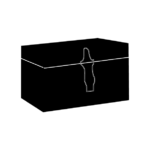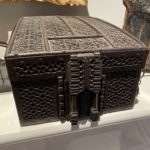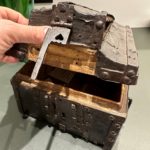DAILY LIFE – FURNITURE

Tiles
- From the 13th to 16th century
- Terra cotta
- Origin unknown; from Pré d’Auge (Normandy) for the glazed tiles
The tiles decorated floors in religious and secular buildings of a certain rank (inns, homes, etc.).
The glazed terra cotta tiles are green with a black background and ochre with a red background, and decorated with geometric designs and fleur-de-lis.

Wardrobe
- 15th century
- Oak and wrought iron
- France
Unlike a chest, the wardrobe cannot be transported, but always stays in a room. It contained spare clothes, precious objects, weapons, dishes, papers and books. From the 18th century it was named differently according to its specific use: a linen cupboard, chest of drawers, clothes wardrobe, display cases for dishes, bookcase, etc.

Money changer’s table
- First half of 16th century
- Walnut
- German-speaking Switzerland
This table can be fully dismounted. The money changer, who would travel from fair to fair, used it when « changing » foreign currencies. It includes a drawer and sliding board.

Portable candle-holder with spike
- 13th century
- Champlevé copper, enamel and gilding
The base has three rotating feet each decorated with the same coat of arms: a castle, eagle and bands.
Each foot could be rotated and folded away and has an animal’s head at the end.

Set of messenger chests
- 15th, 16th and 17th centuries
- Wood and wrought iron
- France and unknown origin
This type of chest contained letters or important items to be delivered by a messenger. The chest had a handle and two loops on one of the long sides, so that the messenger could tie it to his horse or hang it from his belt.

Missal case
- Late 15th century
- Forged iron with oak interior
- France
This case contained a missal, the liturgical book used by worshippers in church with the main elements and prayers in Catholic masses.

Chest with secret compartment
- Early 16th century
- Wood from a resinous tree, leather and wrought iron
A « secret » compartment is hidden in the lid. It was designed to contain an important document or precious object.

Tripod cauldron
- 16th century
- Bronze
This cauldron could be hung above the fire from the wrought iron handle to cook meals. It stands on three feet (tripod) in the form of lion’s paws.

Pair of andirons
- 15th century
- Wrought iron
- France
Logs were placed on andirons in the fireplace. The andirons are decorated with faces, jugs, ropes and fleur-de-lis.

Set of Gothic candle-holders and candlesticks
- Late 15th century
- Brass and bronze
- Flanders
From the 14th to the 17th centuries, brass and copper candlesticks were used in some homes. There are two vertical openings at the socket to make it easier to remove the stub of the burnt candle.

Oil lamps
- Medieval period
- Terra cotta
In France in the Middle Ages, field mustard* oil was used in lamps in the north and walnut oil in the south. The alternative to the oil lamp was a torch, adapted to use out of doors, and the candle, inside homes.
*A plant similar to rapeseed, grown for its oil-producing seeds.

Key ring and key pendant
- 15th century
- Wrought iron and bronze
These rings were worn on the finger or hung from a large ring so that they would not be lost or stolen.

Mortars and pestles
- 16th-17th century
- Bronze
Pestles were used with mortars (the recipient) to grind food, minerals, plants, etc.
Minerals were used to make pigments, and plants to make medicinal preparations (infusions, balms, etc.).

Seal pendant
- Medieval period
- Bronze
Here the seal is worn as a pendant. On the seal are engraved symbols belonging to a sovereign authority, a ruling body or a private individual. The seal was pressed on a soft material, wax or lead, to print the symbol and guarantee authenticity.

